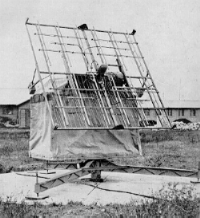|
'Metox'
The Metox radiotheodolite was radio direction finding equipment that was manually steered by the operator to track the transmission from the radiosonde.. Metox sets were installed in Cocos Island, Pt. Hedland and Darwin in
1952, Norfolk Is. in 1955, Lae in 1956 and Honiara in 1958. The last
set was installed at Davis in the Antarctic in 1961.(1)(2) When WF44 radars were installed at Brisbane Airport and Darwin in 1968 documentation indicated a Metox was also installed at that time. There is mention of a Metox at Macquarie Is. in 1957.(3) |
 |
By May 1992 the last two remaining sets were at Cocos Island, and Davis and they were decommissioned soon after, ending an association with the Metox that lasted forty years.
They had limited range and accuracy and were difficult to manage.
Chris Bain, reminisces about from his time on the Metox at Lae PNG, and Cocos
Is.
"The Metox ('Meatbox') display was a small green CRT mounted vertically
in the cabinet and viewed via a 45Deg mirror through a cut - out front panel.
The signal consisted of four squared top peaks from a base line representing
the 4 aerial segments. The idea was to keep all 4 peaks at the same height,
thus the aerial segments were receiving equal signal strengths. This meant that
you were pointed at the radiosonde transmitter attached to the balloon. The
left hand pair represented elevation and the right hand pair, azimuth. The readings
were then taken from dials that were cable driven from the Azimuth and Elevation
gear boxes.
The thing was very observer friendly in that one could be well off the target
and still have some signal to follow, however moisture in the aerial switching
motor usually meant a good solid signal until one peered out of the side window
in the canvas tent and spied the balloon up to 90 deg from the aerial heading!
"(5) -
More
Observer memories
(1) Metarch
papers No. 13, A very special family: Memories of the Bureau of Meteorology
1946 to 1962 by W J Gibbs
(2) Metarch
papers No. 8, History of Major Meterological Installations in Australia 1945
to 1981by Reg Stout
(3) Documentation
of Installation / Projects sections
(4) Metarch
papers No. 14, Stories from the Bureau's Radio Technical Officers from 1948
- Peter Copland
(5) Chris
Bain, Perth Airport Met. Office (private communication)
(6) Reg Carter
(private communication)
(7) Central Workshop overhaul notebook